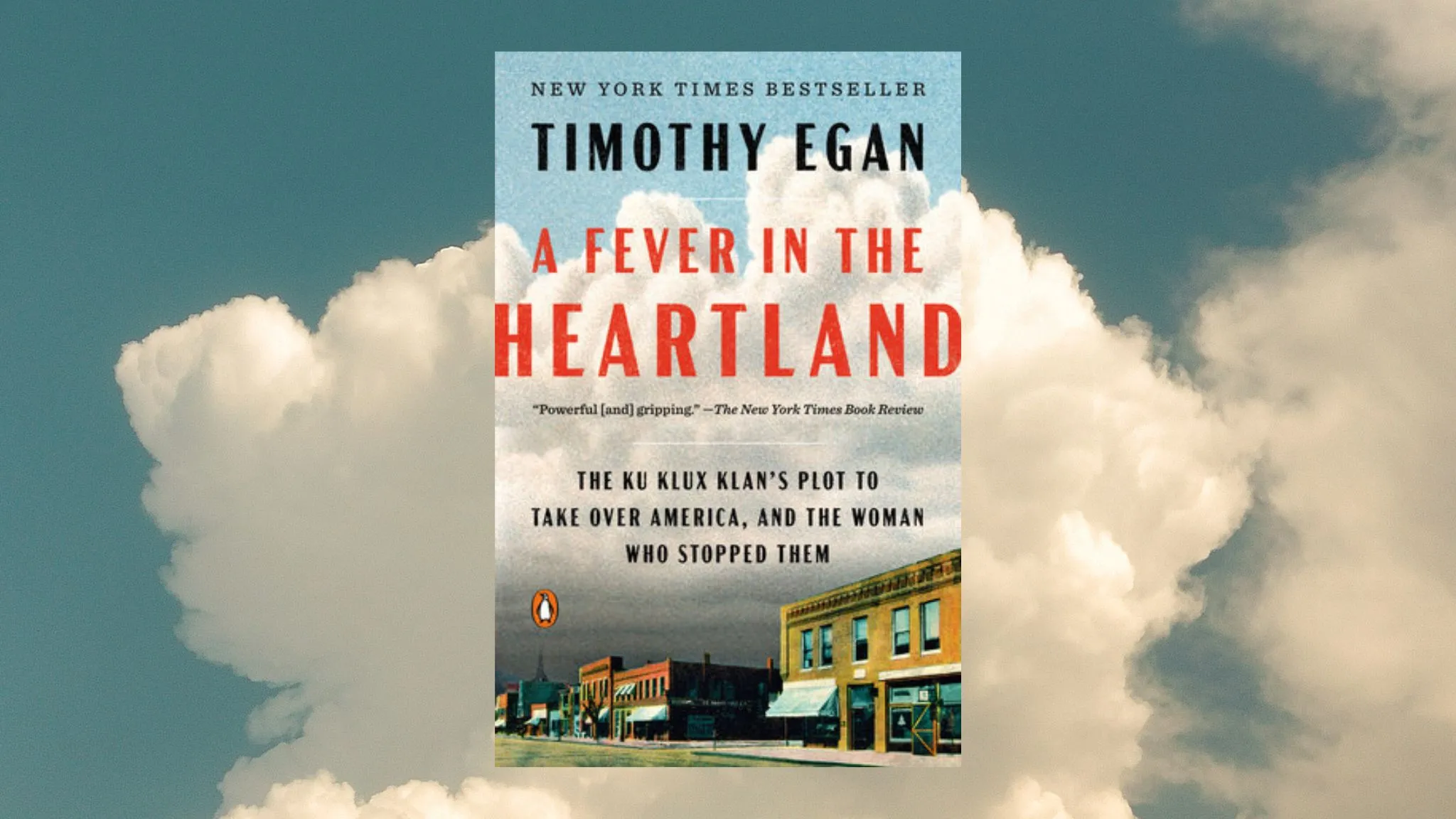A Fever in the Heartland by Timothy Egan
American history is replete with horrors that have been buried over time. Like an ancient skeleton that may never be discovered, the stories remain untold unless someone comes along to excavate.
That is exactly what occurred when Timothy Egan, a Pulitzer Prize-winning reporter, decided to write about the Ku Klux Klan’s reign in the state of Indiana during the 1920s. A Fever in the Heartland (now in paperback) blows up the standard narrative that the Klan’s years of greatest influence followed the Civil War.
KKK’s Reign of Terror
In fact, the Klan’s second ascendancy began in 1915 atop a vast granite dome in Stone Mountain, Georgia, where fifteen men led by a dissolute minister, William J. Simmons, declared “allegiance to the Invisible Empire of a new age,” Egan writes.
The new dominion did not come out of the blue. Enraged by social change, many Americans were ready to align themselves with hatred and violence. Not unlike today, these nativists believed that their country had been taken from them, and they wanted it back.
Since the 1880s, emigration from southern and eastern Europe had brought millions of “aliens” to American shores, augmenting the immigrant population of the Irish and Germans who began arriving in the 1840s. Putting a stop to these waves of immigration was a Klan priority.
Klan members also opposed women’s suffrage, enacted in 1920, and supported Prohibition, enacted in 1919. They did not like the way that cities were gaining political power and cultural influence as the population shifted from rural to urban areas.
Modern art, music, and literature infuriated the Klan. So did the rise of a defiant, daring younger generation and its challenge to authority in the form of new fashion, manners, and ideas.
And from the Klan’s perspective, there were never enough Jim Crow laws, no limits on terror and brutality to inflict on Black citizens. There were always more rights and privileges to deny Black citizens, always new ways to degrade and destroy Black lives.
By 1923, the Klan boasted three million members nationwide and was “the fastest growing fraternal order in the land,” Egan reports.
True History of Dangerous Con-Man
The man who brought the Klan to Indiana was David C. Stephenson, known as “DC.” He arrived in Evansville in 1922, one year after swearing an oath to the Klan. DC’s assignment came from the top: establish a northern outpost. He accomplished this brilliantly despite his vulgar persona — or perhaps because of it.
“He liked heavy food, a good cigar, and many a drink,” Egan writes. “He looked prosperous, even if he wasn’t. He sounded educated, an incontinent user of five-dollar words, even if the college he’d attended changed with each telling. But the truth of his background didn’t matter; his swagger was convincing.”
DC was more beast than human being, a misogynistic rapist who beat and mutilated women. They dared not inform the police until one woman did … precipitating his downfall. But that was in the future.
He set forth to corrupt Indiana. He and his henchmen sought control of the populace in three ways. Foremost, the Klan insinuated itself into daily life and rites of passage, showing up at picnics, parades, baptisms, public meetings, and ceremonies related to the schools and local government. Unsurprisingly, membership soared in local chapters of Women of the Ku Klux Klan and the Ku Klux Kiddies.
Chilling and Resonant Piece of US History
Further, the Klan threatened and strong-armed Blacks, Jews, Catholics, and even white Protestants who refused to join the organization. You might be brave but you were always looking over your shoulder. Klan members burst into churches and synagogues and bullied clergy, harassed shopkeepers, jailed and lynched Blacks.
They burned crosses everywhere, including the University of Notre Dame in South Bend. Denied a parade permit, they swarmed the campus, never anticipating that students—including some very tough football players — would come after them to fight, tear off their robes and hoods, and corner them in an office building.
Finally, the Klan infiltrated politics. They came to own the governor, mayors, state legislators, and judges. They owned state and local police and acted with impunity.
“I am the law,” declared DC Stephenson.
It wasn’t just Indiana, of course. Nationwide, the Klan flourished. By 1925, the Klan boasted six million members. One year later, 50,000 Klan members traveled to Washington, D.C. to march down Pennsylvania Avenue before 200,000 spectators.
By that time, DC Stephenson had landed in jail. Assisted by two goons, he had abducted and abused a young woman who wasn’t afraid to speak out. At long last, DC was prosecuted to the full extent of the law, and the Klan eventually lost its grip on Indiana.
You’ll have to read the book to find out how that came to be. The 1920s encompassed far more than jazz and bathtub gin. It was a dark time in American history.
About Timothy Egan:
 Timothy Egan is a Pulitzer Prize-winning reporter and the author of eight books, including The Immortal Irishman, a New York Times bestseller. His book on the Dust Bowl, The Worst Hard Time, won a National Book Award for nonfiction and was named a New York Times Editors’ Choice, a New York Times Notable Book, a Washington State Book Award winner, and a Book Sense Book of the Year Honor Book. He writes a weekly opinion column for The New York Times.
Timothy Egan is a Pulitzer Prize-winning reporter and the author of eight books, including The Immortal Irishman, a New York Times bestseller. His book on the Dust Bowl, The Worst Hard Time, won a National Book Award for nonfiction and was named a New York Times Editors’ Choice, a New York Times Notable Book, a Washington State Book Award winner, and a Book Sense Book of the Year Honor Book. He writes a weekly opinion column for The New York Times.
(Photo Credit: Ruth Fremson)





